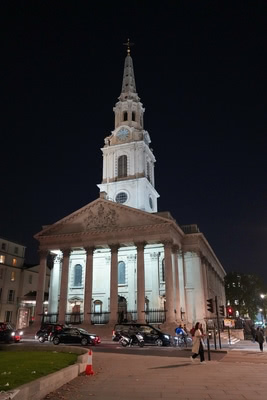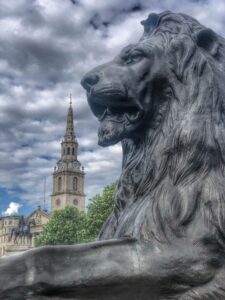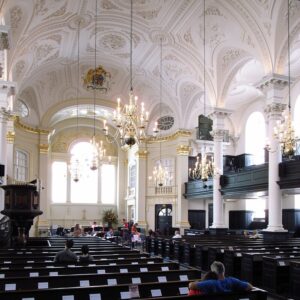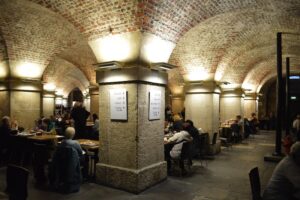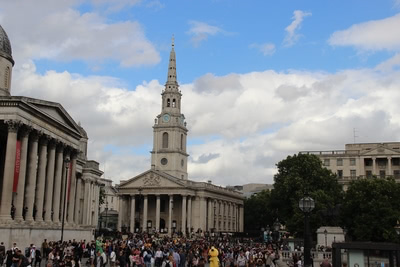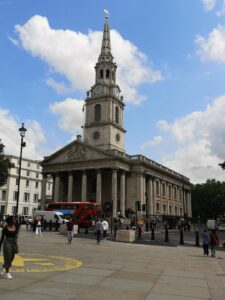What Is St Martin In The Fields? And Why Should You Visit?
Date post added: 15th February 2023
The church of St Martin in the Fields is a historic church in central London. This significant parish church has a vast history. A church has stood on this prime London site since 1222. It’s a Church of England (Anglican) parish church. It’s named after St Martin of Tours.
But what makes this church so special? From its historic stature to its prominent position and, importantly, its help for those in need, there are many things to admire about St Martin in the Fields. Here, we give 10 good reasons to visit the church of St Martin in the Fields.
Why you should visit St Martin in the Fields
1. Its central London location
St Martin in the Fields is right in Trafalgar Square in the heart of London. It’s a prime location in the West End (the city of Westminster to be precise). This corner of Trafalgar Square hosts the National Portrait Gallery and the National Gallery as well as swanky hotels.
As you stand in Trafalgar Square amidst the pigeons and with Nelson’s Column towering over you, stand back and admire the grandeur of this incredible church. You may recognise it from the annual new year celebrations nearby or films like Notting Hill.
Its location also makes it easy to get to. Take your pick from Charing Cross, Leicester Square, Embankment or even Piccadilly tube stations and walk from there.
Given its Trafalgar Square address, it’s the local parish church for the London-based Royal Family and also the residents of 10 Downing Street.
2. The concert series
St Martin in the Fields is a wonderful venue for music. On a near daily basis, live music events are held here spanning everything from chamber music to musicals and even silent discos. Look out for the lunchtime concerts of classical music or wonderful jazz and folk evenings too.
Many of these concerts are free. Others are £20 including a fish and chips supper. It doesn’t get better than that in central London.
They support new artists and you’ll see concerts by up and coming musicians there. There’s even The Academy of St Martin in the Fields who return to their namesake venue to play orchestral and chamber music. It really is something special.
3. The Cafe in the Crypt
Escape from the bustling London streets to the wonderful, welcoming space that is the Cafe in the Crypt. It’s an unusual setting in the vast vault of the church. It’s not often you get to sip a cup of tea amongst historic tombstones, but it’s the perfect place for some respite.
Also worth a look is the little gift shop and gallery. You’ll find an array of historic monuments, a whipping post and the memorial to the founder of the Pearly Kings and Queens (a lifesize model no less).
4. Their charitable works
The church prides itself in responding to changing needs in society. They really put their money where their mouth is and do lots of good works with the funds they raise. Since the early 20th century, they’ve been helping the homeless in particular.
During World War I, Dick Sheppard was the Vicar of St Martin’s. He opened the church doors to provide refuge for soldiers. Those doors have remained open to those in need ever since.
This church was also London’s first free lending library. They were involved in the founding of The Big Issue and Amnesty International too. Once a year, the Friends of Dorothy take over the bell ringing as part of the Pride celebrations.
St Martin in the Fields is proud to accept all faiths, encouraging all to pray together in its church, showing others the way it could be done.
5. Its fascinating history
The church gets its first mention in Norman times, 1222 to be precise. It was caught up in a spat between the Bishop of London and the Abbott of Westminster. The Archbishop of Canterbury ruled in Westminster’s favour.
Fast forward to 1542. Henry VIII didn’t want plague victims getting too close. He extended parish boundaries to prevent funeral processions going through Whitehall Palace to get to St Margaret’s, the then parish church. Making St Martin in the Fields a parish church, spared His Majesty the ghastliness of corpses being borne along right under his nose. The original building was torn down and a new one was built.
Under JamesI’s reign it was extended to accommodate the increase in population. But he also set up new parishes nearby, including St James and Soho, to relieve the pressure on St Martin’s.
It was demolished again in 1721 and the church as it is now was completed in 1726. This 18th century building was beautifully designed by James Gibbs, more of whom later.6. The origins of its name
The patron saint, St Martin of Tours has an interesting story. As a young Roman officer, Martin gave half his cloak to a starving beggar at the gate. That starving beggar turned out to be Jesus. That encounter changed Martin’s life. He rejected army life and decided to become a saint (as you do).
The church of St Martin in the Fields is so named for a couple of reasons. Churches named St Martin’s are always on the edge of town as that’s where the officer had his life-changing encounter with the beggar. Whilst the church is in a very central London location today, centuries ago that was the edge of the city which is why it is ‘in the field’.
Of course, these days St Martin in the Fields is too much of a mouthful for many so you may well hear it referred to as SMITF.
6. It’s a peaceful haven
The church with the open doors is a place for tranquillity and reflection for all, in the middle of the often hectic Trafalgar Square. It’s a wonderful space in which to press pause for a while.
There’s a relatively new Prayer Garden – a hidden gem in central London – in which to pray, meditate or just relax. They also run a wide range of events in the Crypt, meditation being one of them (brass rubbing is another).
7. Its inspirational design
The present church was designed by James Gibbs in the 18th century. The church is rectangular in design with Corinthian pillars, a portico on the west front, an integrated tower and a steeple which is 59 metres high.
James Gibbs’ church is cited as one of the most significant ecclesiastical buildings in the English-speaking world. It became the blueprint for many US churches which may explain why Americans tend to feel so at home there.
8. Famous burial spot
There are notable people who have been buried at St Martin in the Fields. Furniture maker Thomas Chippendale is one of them. He had a workshop around the corner on St Martin’s Lane which secured him a place there for eternity. The infamous ‘Honest Jack’ (Jack Sheppard), a thief, prison escapee and thoroughly bad lot also made it his final resting place. And Charles II’s favourite squeeze, Nell Gwynne was also buried there. She was a consummate Londoner, adored by her people (as well as the then king).
9. Herbert Lomas’ wonderful poem
A wonderful way to visualise the experience of visiting St Martin in the Fields is by reading Herbert Lomas’ beautiful poem about the place. “City churches aren’t always easy to pray in” it begins. Listen to it here
Explore more incredible ecclesiastical buildings in London with our City Churches Walk
Find more details of the church’s fascinating history at https://www.stmartin-in-the-fields.org/

